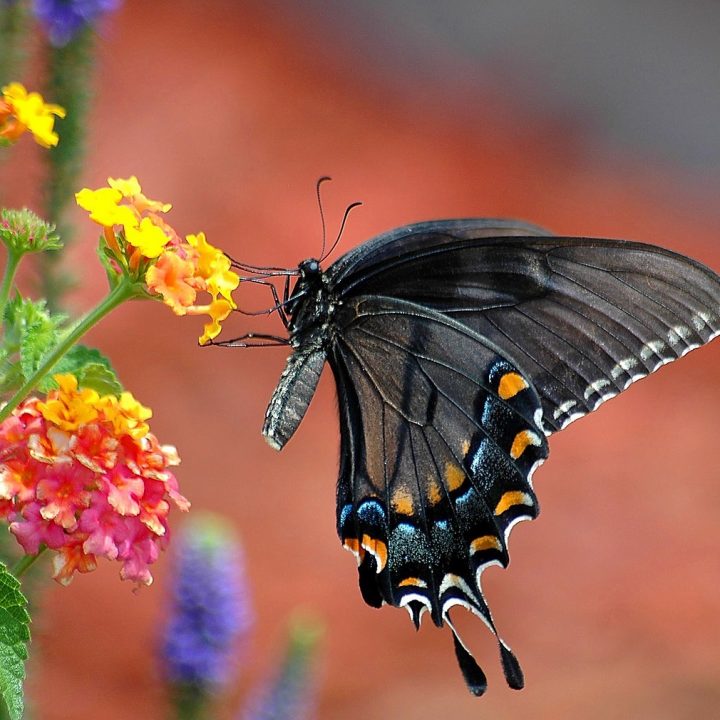The flitting flight of butterflies in the garden is always enchanting and entrancing. More than visual delight and meditative moments, planting more flowers for attracting butterflies will help your yard and garden thrive.
Like flower petals given wings to fly, it’s easy to pause and watch, entranced, as these beautifully delicate creatures flit and flirt from flower to flower.
Butterflies are beautiful insects, known scientifically as Rhopalocera from the order Lepidoptera, which includes moths.
Happiness is a butterfly, which when pursued, is always just beyond your grasp, but which, if you will sit down quietly, may alight upon you.
~Nathaniel Hawthorne, American writer, novelist, 1804-1864

How Butterflies Benefit Your Garden
Attracting butterflies is more than a relaxing way to interact with nature. Indeed, the presence of these exquisite creatures is a key indicator of a healthy ecosystem.
Essential Pollinators
Butterflies are not only a living garden ornament. They are essential pollinators that can help your garden thrive. As they dance from flower to flower, they pick up pollen from the petals on their wings. When they land on the next flower, the pollen drops onto it.
While their method is less effective than that of bees, they are still vital contributors to pollination.
Controlling the Aphid Population
Aphids are destructive to your garden. This is because they are voracious eaters who snack on the leaves of your favorite plants, shrubs, and flowers.
While butterflies are in their caterpillar form, one species is known to consume aphids. This helps to minimize the number of aphids present in your garden.
The notable caterpillar who eats aphids is the Harvester butterfly, Feniseca tarquinius, the only fully carnivorous butterfly from caterpillar to adulthood.
SOURCE: The-Natural-Web.org
Food chain
As a part of the food chain, butterflies are not only predators of aphids. In fact, they are also prey. Bats and some species of birds consume butterflies as a part of their healthy diets.
When you have a thriving population of butterflies present, you’ll attract those predators. While this sounds terrible, remember bats and birds also provide natural mosquito control.
See birds that eat mosquitoes here.
What Types of Flowers and Plants Attract Butterflies?
Butterflies are not just stopping by to admire your stunning garden. They are there for a free meal. In the majority of cases, butterflies dine on the nectar produced by your garden plants and flowers.
Their strong preference is for pink, red, yellow, purple, or orange flowers with shorter flower tubes. They also prefer to bask in the afternoon sun as they feed. Selecting plants and locations that meet these criteria will help you in attracting butterflies to your garden.
List of Best Plants and Flowers for Attracting Butterflies
We have done the research and rounded up a list of tried-and-true plants and flowers to attract butterflies to your garden. If you are researching how to start a butterfly garden, this is a must-read list!
1 – Yarrow (Achillea millefolium)
Perennial, zones 3 to 9
The relatively flat shape of yarrow flowers and large clusters of vibrant blossoms make yarrow one of the best flowers to attract butterflies.
You’ll love the feathery foliage that adds texture to your garden. Yarrow plant loves the full sun but can also grow in filtered sunshine.
Yarrow Flowers for Attracting Butterflies Like These:
- American Copper
- Banded Hairstreak
- Lorquin Admiral
- Red-banded Hairstreak
- West Coast Lady

2 – Snapdragons (Antirrhinum majus)
Annual, zones 3 to 8; perennial, zones 9 to 11
Snapdragons are a Mediterranean native plant that loves warm, sunny spots in the garden. The tightly clustered flowers and bright flowers make this one of the best plants for butterflies.
Not only do snapdragons provide nectar for the butterflies, but the undersides of their leaves also offer a safe place for them to lay their eggs.
Plant your snapdragons in the filtered sun to partial shade in a well-drained location.
You will love snapdragons because they grow fairly tall and make for great cutting stems for you to enjoy. While they are best known as an early-summer bloomer, snapdragons start in the late spring in some zones.
Snapdragons for Attracting Butterflies Such As:
- Cabbage White
- Common Buckeye
- Grey Hairstreak
- Pearl Crescent
- Swallowtail

3 – Shasta Daisy (Leucanthemum)
Perennial, zones 5 through 8
The Shasta daisy is a traditional perennial flower with a crisp, white flower and cheery sunny florets. This species is a gardener’s favorite for its ease of care.
Unlike some species of daisy, the Shasta daisy is non-invasive. Give it nothing but a sunny bed, well-drained soil and water, and it will thrive year after year.
Butterflies find the yellow floret in the middle of the flower intriguing and many species will visit your garden.
Shasta Daisy Flowers for Attracting Butterflies Like:
- American Painted Lady
- Cabbage White
- Eastern Tiger Swallowtail
- Painted Lady
- Pearl Crescent
- Queen
- Red Admiral
- Sachem
4 – Black-eyed Susan (Rudbeckia hirta)
Perennial, zones 3 through 9
The Black-eyed Susan has a face that lifts to the sun every afternoon. While it’s best known for a vibrant yellow flower, varieties are also available in red and orange.
Black-eyed Susan has a strong preference for full sunshine and doesn’t like her feet to stay wet for long.
Considered one of the “easiest perennials to grow” by the Old Farmer’s Almanac, you will enjoy this species. Moreover, butterflies love this flower, too!
Black-Eyed Susans Flowers for Attracting Butterflies Such As:
- American Snout
- Great spangled fritillary
- Hayhurst’s Scallopwing
- Orange Sulphur
- Pearl Crescent
- Sachem
- Silver-spotted Skipper
- Silvery Checkerspot
- Spring Azure
- Summer Azure
5 – Lantana (Lantana)
Perennial, zones 8 through 11
Lantana is more than just one of the best flowers for butterflies. It’s also a great plant to attract hummingbirds, too!
They are a native to India and love warm to hot weather and can’t tolerate more than a light frost. If you have a problem with deer invading your garden, lantana is one of the best deer-resistant flowers.
Lantana blooms most vibrantly in full sunshine. It likes humid growing conditions, but you must keep the soil drained.
Lantana Flowers for Attracting Butterflies Like:
- Cabbage white
- Fiery Skipper
- Gray Hairstreak
- Great swallowtail
- Hayhurst’s Scallopwing
- Little Glassywing
- Monarch
- Red Admiral
- Sachem
- Silver-spotted skipper
- Skipper
- Spicebush Swallowtail
- Swallowtail
- Wild Indigo Dusky Wing
- Zebra Longwing

Monarch Butterfly on Lantana Flower in Slow Motion
6 – Phlox (Phlox)
Perennial, zones 2 through 9
Phlox are forgiving flowers that grow in an enormous span of hardiness zones. Also, these plants can grow in the sun through part-shade.
While the species can grow in partial shade, phlox will be more abundant and vibrant when grown in the full sun. Of course, those brighter shades are preferred by butterflies. The flowers require loamy soil.
Blooms come in pink, red, purple, white, and blue.
Phlox Flowers for Attracting Butterflies Such as:
- Sachem
- Silver-spotted Skipper
- Silvery Checkerspot
- Spicebush Swallowtail
- Swallowtail
- Tiger Swallowtail
- Zabulon
7 – Ornamental switchgrass (Panicum virgatum)
Perennial, zones 3 through 9
If you’re considering a tall, lush-looking ornamental grass that adds height to your butterfly garden, consider switchgrass. You’ll love the texture the feathery spikes when the grass matures.
This ornamental is so easy to grow that many states grow to naturalize areas around interstates and then leave it to grow on its own.
Butterflies seek out switchgrass not for dining, but as a safe place to lay their eggs. This is because the tall grass provides relative safety from predators.
Switchgrass is a drought-tolerant full-sun grass that grows as high as 8 feet tall in almost every zone.
Switchgrass for Attracting These Butterflies:
- Black Dash
- Broad-winged Skipper
- Dion Skipper
- Dun Skipper
- Northern Broken Dash
- Woody Nymph
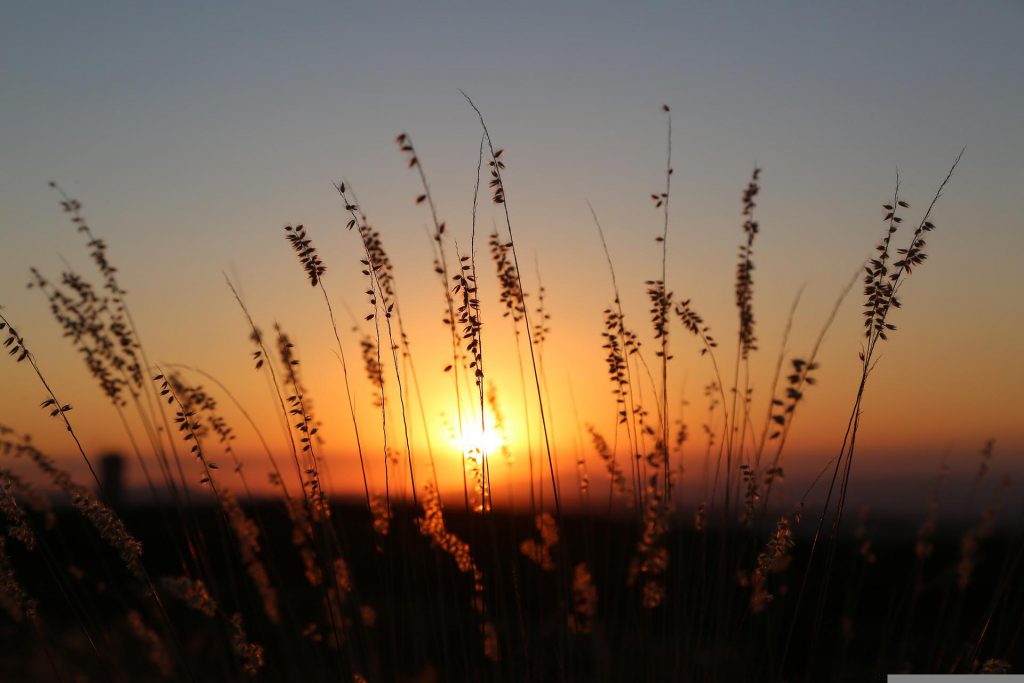
8 – Lavender (Lavandula)
Perennial, zones 5 through 9
It turns out that one of the most popular herbs and medicinal plants, the lavender, is also one of the best plants for butterflies!
A native of the Mediterranean and Northern Africa, lavender flourishes in a sunny, drier place in the garden.
While you may enjoy harvesting it for sipping as a tea or perfuming your bath water, the purple flowers on the lavender will attract butterflies galore.
See growing lavender and make lavender oil.
Lavender Flowers for Attracting Butterflies Such as:
- Cabbage White
- Hairstreak
- Monarch
- Peck’s Skipper
- Sachem
- Silver-spotted Skipper
- Spring Azure
- Summer Azure
9 – Aster (Asteraceae)
Perennial, zones 3 to 8
While most of the flowers we’ve mentioned so far bloom from the late spring to mid-summer, asters bloom from the late summer and into the autumn (depending on your hardiness zone).
However, planting aster provides a nectar source for butterflies all the way through September! But, that’s not all aster provides the butterflies. This plant also has dense green leaves during the early part of the growing season where butterflies will lay their eggs.
Asters thrive in either full or filtered sun. Additionally, they prefer sandy soil and moist conditions. But, they don’t prefer to get too wet!
This plant offers varieties with purple, red, white, pink, or blue flowers. Of course, the butterflies will be most attracted to the purple and red blossoms.
Asters Flowers for Attracting Butterflies Like These:
- American Lady
- American Snout
- Anise Swallowtail
- Black Swallowtail
- Buckeye
- Cabbage White
- Clouded Skipper
- Clouded Sulphur
- Common Checkered Skipper
- Eastern Tailed-blue
- Fiery Skipper
- Gray Hairstreak
- Lorquin Admiral
- Monarch
- Orange Sulphur
- Pearl Crescent
- Peck’s Skipper
- Question Mark
- Red Admiral
- Red-banded Hairstreak
- Sachem
- Silver-spotted Skipper
- Swallowtail
- Variegated Fritillary
- Viceroy
- West Coast Lady
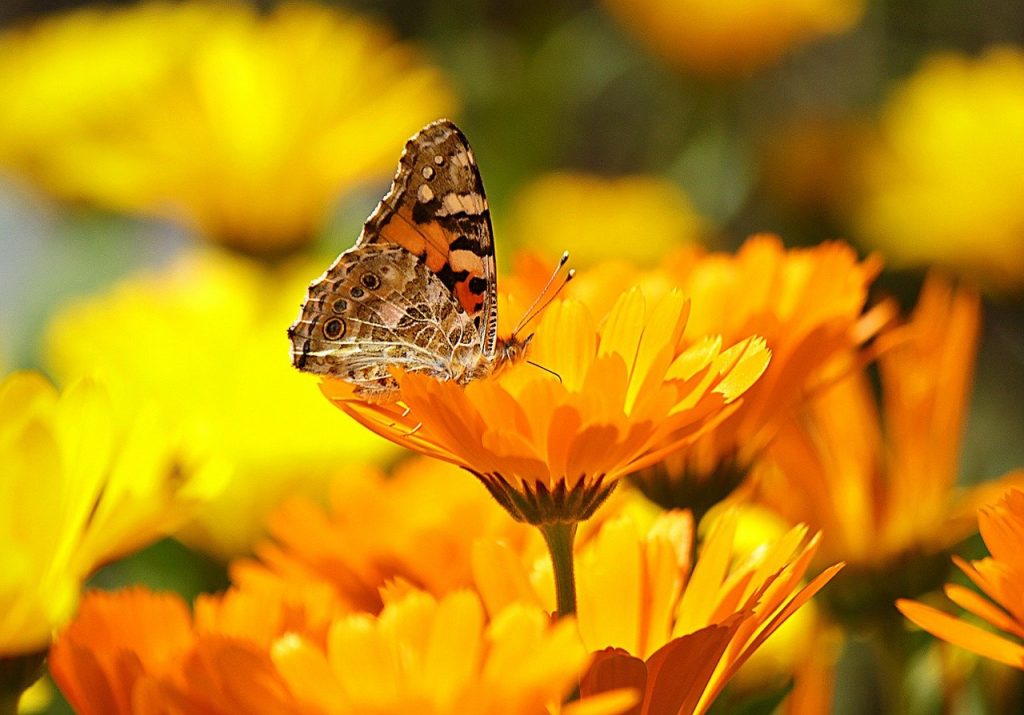
10 – Butterfly bush (Buddleia davidii)
Deciduous shrub, zones 5 to 10
We can’t have a blog post about how to attract butterflies without including the best-known butterfly-attracting plant, can we? And that, my friends, is the butterfly bush.
Butterfly bush varieties offer options that bloom purple, white, pink, red, or yellow. It shows off its colors from mid-summer through fall in most hardiness zones.
A butterfly bush is easy to maintain. It needs only a simple deadheading of spent blooms in the summer. And, in the late winter to early spring, give it a pruning to shape it attractively.
Plant this in any soil type in the full sunshine.
Butterfly Bush Flowers for Attracting Butterflies Such as:
- American Lady
- Anise Swallowtail
- Banded Hairstreak
- Black Swallowtail
- Cabbage White
- Cloudless Sulphur
- Crossline Skipper
- Eastern Comma
- Eastern Tiger Swallowtail
- Fiery Skipper
- Giant Swallowtail
- Great Spangled Fritillary
- Gulf Fritillary
- Horace’s Duskywing
- Little Glassywing
- Monarch
- Mourning Cloak
- Ocola Skipper
- Orange Sulphur
- Painted Lady
- Peck’s Skipper
- Pipevine Swallowtail
- Poludamus Swallowtail
- Queen
- Question Mark
- Red Admiral
- Red Spotted Purple
- Red-banded hairstreak
- Sachem
- Silver Spotted Skipper
- Southern broken dash
- Spicebush Swallowtail
- Spring Azure
- Summer Azure
- Variegated Fritillary
- Viceroy
- Wild Indigo Duskywing
- Zabulon
- Zebra Longwing
- Zebra Swallowtail
11 – Milkweed (Asclepias syriaca)
Perennial, zones 4 through 9
The milkweed flower is a native plant to North America that’s easy to grow. Provide it bright sunshine and well-amended soil, and you will see butterflies all season long.
Honorable mention should go to the butterfly weed (Asclepias tuberosa) for it’s highly attractive quality that has earned it’s name.
This plant provides nectar as well as a safe harbor where butterflies can lay eggs. As caterpillars mature, they remain shielded from predators.
Milkweed is of particular importance to the Monarch butterfly, an endangered species. While adult monarchs can consume a variety of nectar, Monarch caterpillars eat only one thing: milkweed leaves.
See our monarch butterflies and milkweed article.
Planting milkweed helps to preserve this waning Monarch butterfly species for future generations; it’s a kind thing to do for our ecosystem.
~GardensAll
Milkweed Flowers for Attracting Butterflies Such as:
- American Copper
- American Lady
- Baltimore Checkerspot
- Banded Hairstreak
- Black Swallowtail
- Bronze Copper
- Cabbage White, (a gardener’s nemesis for they produce the dreaded cabbage worm)
- Common Buckeye
- Delaware Skipper
- Eastern Tailed-blue
- Eastern Tiger Swallowtail
- Fiery Skipper
- Giant Swallowtail
- Gray Hairstreak
- Great Spangled Fritillary
- Hoary Edge
- Little Glassywing
- Lorquin Admiral
- Monarch
- Mourning Cloak
- Orange Sulphur
- Painted Lady
- Pearl Crescent
- Peck’s Skipper
- Pipevine Swallowtail
- Queen
- Question Mark
- Red Admiral
- Red-banded Hairstreak
- Red-spotted Purple
- Sachem
- Silver-spotted Skipper
- Silvery Checkerspot
- Sleepy Orange
- Southern Cloudywing
- Spicebush Swallowtail
- Spring Azure
- Two-tailed Swallowtail
- Variegated Fritillary
- Viceroy
- Zabulon
- Zebra Longwing
- Zebra Swallowtail
12 – Bee balm (Monarda)
Perennial, zones 3 to 9
Bee balm, a perennial herb, is a well-noted medicinal plant drank as a tea and an ingredient often used in natural cosmetics to add a pleasing aroma.
For a butterfly garden, it’s a hard-working multi-tasker. The pink, white, purple, or red blooms smell lush and fragrant and attract butterflies, bees, and hummingbirds.
This plant attracts adult butterflies because of the sweet nectar. Additionally, it serves as a host plant for their eggs.
Plant bee balm in the full sunshine in loamy soil that will drain well. Keep it well-watered for blue to purple blooms all summer long and into the earliest part of autumn.
And bee balm isn’t just good for the bees and butterflies. There are also many bee balm uses and benefits for people too!
Bee Balm Flowers for Butterflies Like These:
- Anise Swallowtail
- Cabbage White
- Eastern Tiger Swallowtail
- Giant Swallowtail
- Monarch
- Pipevine Swallowtail
- Polydamus Swallowtail
- Sachem
- Silver-spotted Skipper
- Spicebush Swallowtail
- Summer Azure
- Zebra Swallowtail
13 – Ornamental salvia (Salvia)
Perennial, zones 5 through 9
Ornamental salvias are in the same family as culinary sage. The ornamental perennial plants are sun-loving flowers that thrive in almost any soil conditions. Plus, you’ll find that they are easy to grow, drought-tolerant plants. Of course, that fact makes them popular in areas prone to dry conditions.
You can choose from a range of colors: mauve, blue, purple, red, yellow, or white and start attracting butterflies, hummingbirds, and bumblebees.
Salvia Flowers for Butterflies Such as These:
- American Lady
- Cabbage White
- Clouded Skipper
- Cloudless Sulphur
- Dun Skipper
- Fiery Skipper
- Giant Swallowtail
- Gray Hairstreak
- Gulf Fritillary
- Monarch
- Orange Sulphur
- Orange-barred Sulphur
- Peck’s Skipper
- Sachem
- Silver-spotted Skipper
- Spicebush Swallowtail
- Zebra Longwing
- Zabulon
14 – Purple coneflowers (Echinacea)
Perennial, zone 3 through 9
Purple coneflowers are good for our garden friends: birds and butterflies. During the peak of blooming, butterflies imbibe the nectar. And after the flowers are spent, birds will visit to eat the tiny seeds out of the heads of the flowers.
Coneflowers thrive in sunny conditions to slight shade in a loamy soil. The blooms open in the middle of summer and may last until early September in all but the hottest areas. And, they are resistant to drought, making them an easy grower.
Echinacea Coneflowers for Attracting Butterflies Like This Long List of B:
- American Lady
- Banded Hairstreak
- Black Swallowtail
- Clouded Sulphur
- Common checkered skipper
- Common wood nymph
- Dovetail,
- Eastern tailed blue
- Eastern Tiger Swallowtail
- Fiery Skipper
- Giant Swallowtail
- Gray Hairstreak
- Great Spangled Fritillary
- Gulf Fritillary
- Hayhurst’s Scallopwing
- Horace’s Duskywing
- Little Glassywing
- Monarch
- Orange Sulphur
- Painted lady
- Pearl Crescent
- Peck’s Skipper
- Red admiral
- Red-banded hairstreak
- Red-spotted Admiral
- Sachem
- Silvery Checkerspot
- Silver-spotted Skipper
- Spicebush Swallowtail
- Swallowtail
- Tawny-edge Skipper
- Variegated Fritillary
- Viceroy
- Wild Indigo Duskywing
- Zabulon

15 – Goldenrod (Solidago)
Perennial, zones 3-8
When you think of goldenrod, you might think of allergies and sneezing more than you think about butterflies. But, the truth is clear.
Although it may make you sneeze, goldenrod is an essential source of pollen for your yard.
This perennial plant produces bright yellow flowers from late July into mid-September in most areas. The flowers grow in flat clusters that are irresistible to butterflies.
Goldenrod grows in areas from full sun to partial shade in almost any kind of soil and requires very little care. It’s one of the best flowers to attract butterflies if you want to apply minimal effort in your butterfly garden.
Goldenrod Flowers for Attracting Butterflies Such as:
- American Painted Lady
- American Snout
- Clouded Sulphur
- Common Sulphur
- Great Swallowtail
- Gorgone Checkerspot
- Monarch
- Painted Lady
- Pearl Crescent
- Red Admiral
- Red-banded Hairstreak
- Sachem
- Viceroy
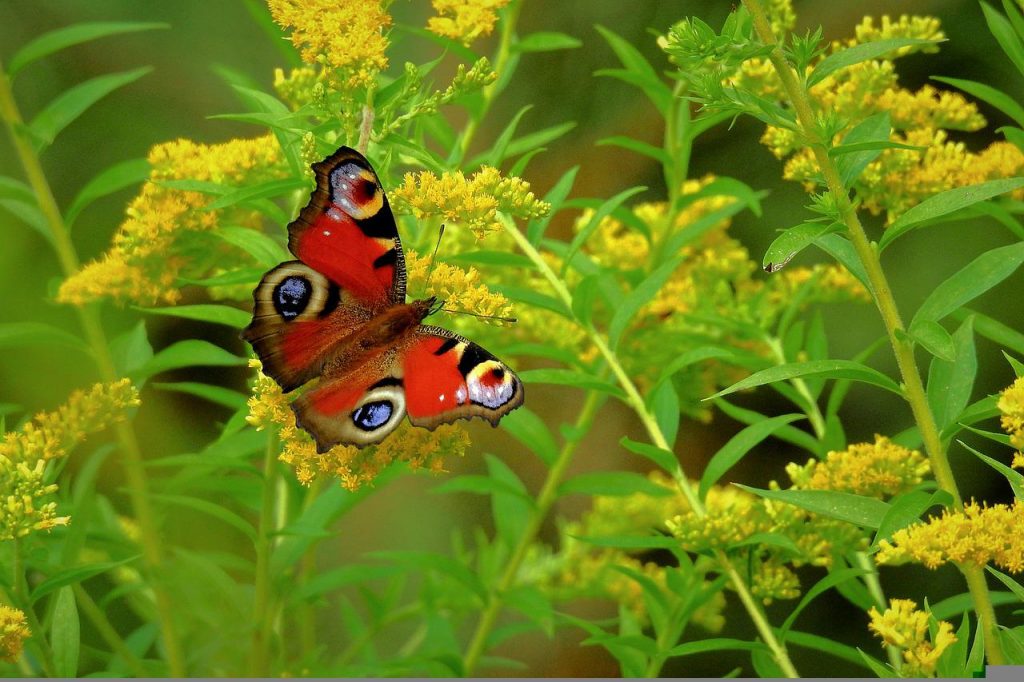
16 – Rosemary (Rosmarinus officinalis)
Perennial and evergreen shrub, zones 6 through 9
It seems like rosemary comes up in almost every blog post I write for GardensAll. Of course, that’s because it’s such a useful plant. Rosemary is an edible herb for seasoning, medicine, cultivated for its lavender-colored blooms, and also for luring those elusive butterflies!
When grown in sandy soil in the full afternoon sun, rosemary can produce almost year-round in zones 7b through 9b. And, it will overwinter well in zones 6 through 7a.
Plant rosemary in your herb garden. Harvest some, but let others grow into full bloom. This practice will encourage the following butterflies will pay you a visit:
- Cabbage White
- Gray Hairstreak
- Monarch
- Peck’s Skipper
- Red-banded Hairstreak
- Sachem
- Silver-spotted Skipper
- Spring Azure
- Summer Azure
17 – Perennial sunflowers (Helianthus doronicoides)
Perennial, zones 4 through 9
The bright faces of perennial sunflowers are similar to their taller, better-known cousins, the annual sunflowers.
While this smaller sunflower species is short in stature, they stand tall in terms of attracting butterflies, bees, and birds.
As the name implies, sunflowers thrive in full sunshine in well-drained, amended soil. It takes all summer for them to grow, however, it’s well worth the wait. The perennial sunflower’s splashy yellow blossoms paint landscapes with bright yellow-orange blossoms n the latest part of summer into fall.
Butterflies hide their eggs under green foliage early in the season then hang out at the nectar bar amongst flowers over summer. Butterflies who love perennial sunflowers are:
- American Lady
- Bordered Patch
- Cabbage White
- Giant Swallowtail
- Gorgone Checkerspot
- Painted Lady
- Gray Hairstreak
- Monarch
- Pearl Crescent
- Sachem
- Silvery Checkerspot
- Spicebush Swallowtail
- Wild Indigo Duskywing
18 — Zinnias
A GardensAll community member said we needed to add Zinnia to this list, and we agree. He said that butterflies love zinnias!
Now you know precisely what some of the best plants and flowers for attracting butterflies are. Therefore, we will leave you with some final tips to make your butterfly garden thrive.
5 Tips for Attracting Butterflies to Your Garden
- Pass on insecticides: It’s tempting to spray chemicals to kill off unwanted insects. However, poison does not discriminate and will also destroy your caterpillar and butterfly population.
- Create a place of rest: All that flittering around is exhausting to butterflies! Place flat rocks that will warm under the sunshine. These will serve as a resting spot for your butterflies after they eat.
- Provide a water source: Butterflies require water. They have an instinct for “puddling,” which is how they rehydrate. Scoop a little bit of sand and some water into a shallow tray to create a human-made puddle. Then, place this into your butterfly garden so they can take a drink now and then.
- Create continuous color: Plant your garden with the intent of continuous color. As one species stops flowering, another one should start to continue to attract butterflies for a longer season.
- Plan for afternoon sun: Butterflies require the sun for two reasons: to warm up their wings so they can fly and for navigating. All of the species we mentioned today are full-sun bloomers because they are the best flowers and plants for butterflies!
Select the best plants and flowers for attracting butterflies and, implement these five additional tips. Soon you’ll have a garden teeming with fascinating caterpillars and butterflies and feel more connected with nature.
Thanks for Visiting and Reading!
If you enjoyed this you’ll also enjoy our article on the hummingbird moth.
And… if you like quotes like these next ones, you may also enjoy our garden memes and sayings article.
Butterfly Quotes and Memes
There she was… dancing in the wind and drinking dewdrops with butterflies… oh flower sublime.
~LeAura Alderson, GardensAll.com
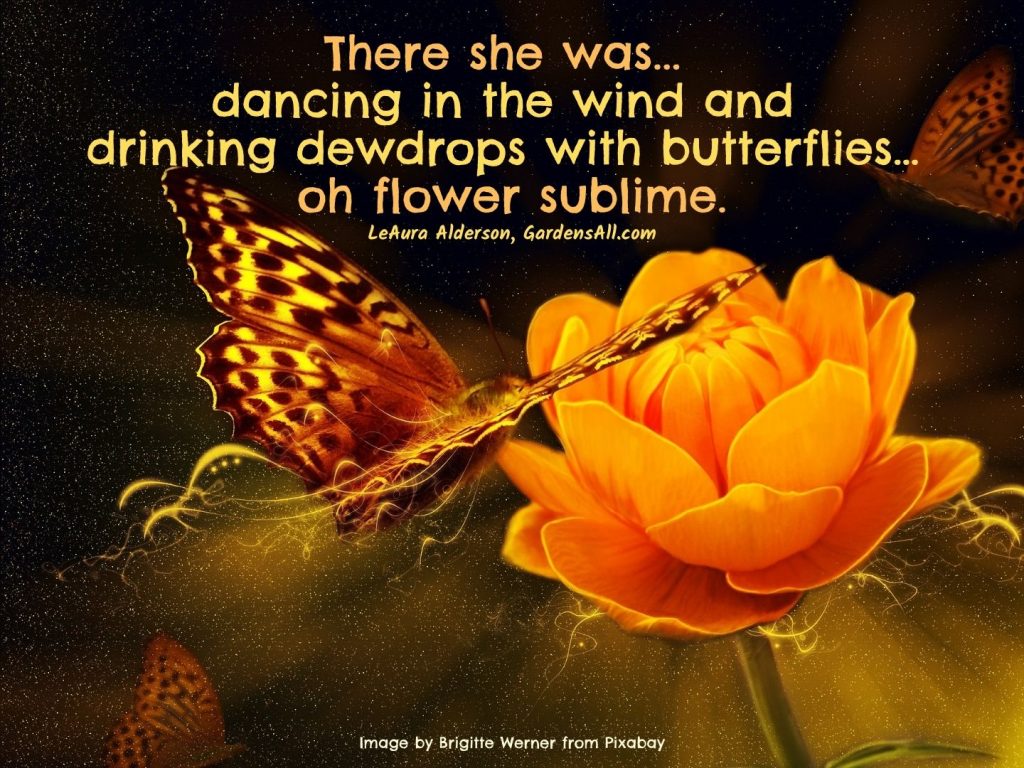
Butterflies are petals set free to fly, and ever to return to the heart of the flower that set them free.
~LeAura Alderson, GardensAll.com
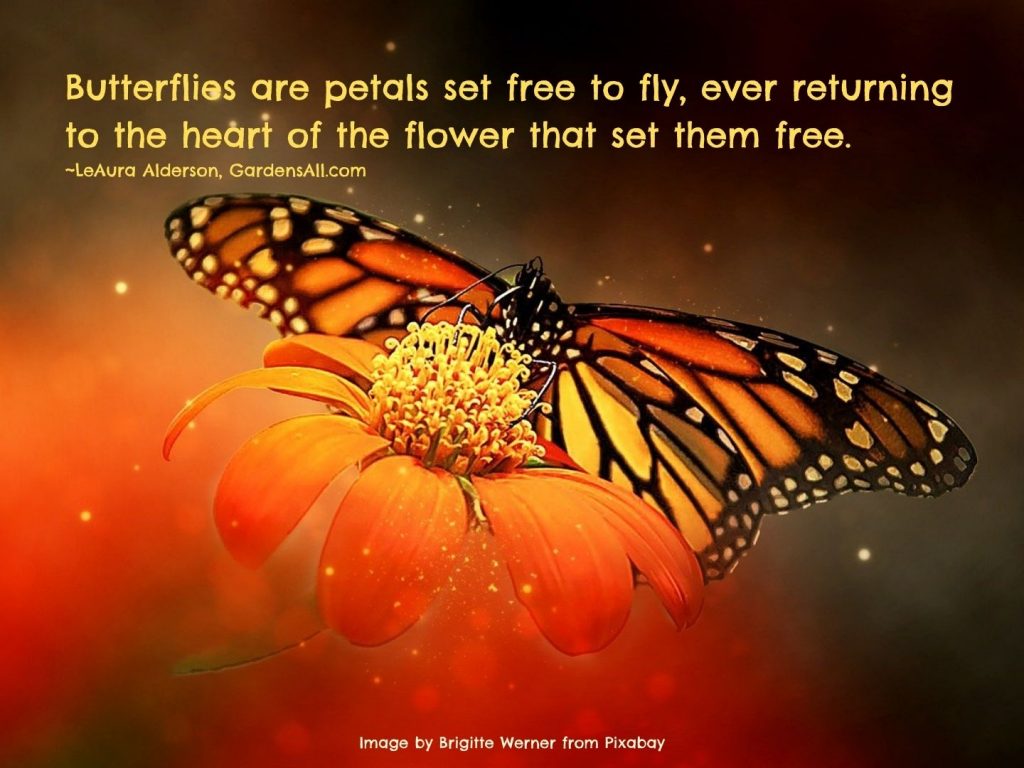
Let’s keep on growing!

Hi! My name is Deborah Tayloe. I’m a full-time freelance writer and blogger. I blog about my favorite things: gardening, cooking, and DIY. I live in a very rural area called Bertie County, North Carolina. Here, I have plenty of open space to pursue my gardening habit. I’m a regular contributor to GardensAll and publish my own blog, DIY Home & Garden.

